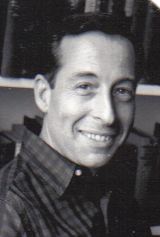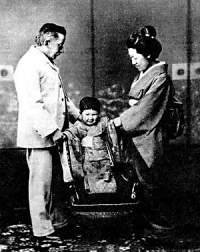 |
Sheldon Kranz Aesthetic Realism Consultant, Writer, Poet (1919-1980) |
|
Aesthetic Realism
Class of July
10, 1968
Taught by Eli Siegel Report by Sheldon Kranz Eli
Siegel has been giving a series of classes on the anthology of Chinese
poetry titled The White Pony, edited by Robert Payne. And he
began the July 10th class with a
discussion of two poems by the 4th-century Chinese poet, Tao Yuan-ming,
whose
poetry we've been studying. What made this discussion particularly
valuable
was that poems sounding not grand or impressive were shown to be
authentic. For
example, take the poem “In Early Morning” which begins:
In
early morning someone knocks at my door.
Throwing on my unbuttoned clothes, I open the door myself. ”Who are you, my friend?” I ask. There is an old, kind, good-hearted man, Bringing with him a wine pot, Believing that I have fallen on evil days. Structure and Melody
About
the first line--"In early morning someone knocks at my
door"--"This," Mr. Siegel commented, "is melodious but
plodding, like a tired angel going upstairs." In the second poem,
"Living in the Country," the most thrilling line is: "Why should
I care when my clothes are wet?"
At the
foot of the south mountain I sow beans;
The weeds tangle them, the bean shoots are weak. I rise early and scratch in the wilderness. Under the moonlight I return with my hoe on my shoulder. The footpath between the furrows so narrow, the grasses so long That my clothes are moistened with dew. Why should I care when my clothes are wet? I only hope to make myself a hermit. (Translations
by Yang Chi-sing) Lafcadio Hearn: He
Saw Art as Kindness
Then
Mr. Siegel looked at the poetic prose of the American writer, Lafcadio
Hearn,
who lived from 1850-1904 and wrote a good deal about Japan and the
East, where he
married and spent the last 14 years of his life. Mr. Siegel
was continuing a discussion of Hearn begun the week before, and he
explained,
"I am discussing him further because Hearn came exceedingly close to
seeing art as unselfishness or good will. It sounds corny to say Hearn
saw art
as kindness, but it is so. Tolstoy was saying something of the same
thing about
this time. But Hearn's way is worth studying." Here are two key
sentences
from a lecture he gave while he was teaching English literature at the
University of Tokyo from 1896 to 1903. This lecture is called "The
Question of the Highest Art." Hearn writes:Just
as unselfishness is the real test of strong affection, so unselfishness
ought
to be the real test of the very highest art....If a work of art,
whether
sculpture, or painting or poem or drama does not make us feel kindly,
more
generous, morally better than we were before seeing it, then I should
say that,
no matter how clever, it does not belong to the highest forms of art.
 "Hearn is saying that what love does in the personal field, art does in the impersonal field," Art as unselfishness was shown dramatically in a story by Hearn called "The Soul of the Great Bell." In this story, a mandarin is unable to cast a great bell successfully for the emperor. The emperor informs him that if he fails in his third try, he will be beheaded. The mandarin's beautiful daughter discovers that the only way the bell can be made is if the body of a maiden is melted in the crucible and blended with the metals. To save her father's life, she leaps into the crucible, and the great bell is cast successfully, beautiful in form and wonderful in tone. Art, Lafcadio Hearn is saying, is successful if there is selflessness. Lafcadio
Hearn (Koizumi Yakumo), wife Setsuko Koizumi, and
child
in Matsue, Japan (photo courtesy of Toki Koizumi) Terror
and Tenderness in "Chita"
As
Siegel discussed this story and a well-known one called "Chita," a
sense of Lafcadio Hearn as artist and person was felt vividly. And a
basic
principle of Aesthetic Realism was shown in action: that all prose and
poetry
is a making one of the permanent opposites in reality. For example, in
the story
"Chita," Mr. Siegel showed how a definite effect is achieved again
and again by putting terror and tenderness or terror and purity
together. There
is the sentence where the innocent child, Chita, feels a snake move
frighteningly under her feet:
All at
once something long and black and
heavy wriggled almost under her naked feet--squirming so horribly that
for a
minute or two she could not move for fright.
And there is the purity and delicacy of this description of the world in the the midst of intense suffering: He
rushed to the windows, flung the latticed
shutters apart, and looked out. Something beautiful and ghostly filled
all the
vistas--frost-haze; and in some queer way the mist momentarily caught
and held
the very color of the sky. An azure fog!...How sweet the morning! How
well life
seemed worth living.
This amidst intense physical pain. There was one paragraph in this story which Mr. Siegel saw as worthy of particular attention. "Hemingway," he said, "could with simplicity place people and a few objects in a way that one remembered. This paragraph of Hearn's is as good as Hemingway. It is as if a painting were painting itself before you. It is simply a gathering--but what a gathering!" Here is the paragraph: All proceeded to the house under the great trees; Feliu and Capt. Harris leading the way. It was sultry and bright; --even the sea breeze was warm; there were pleasant odors in the shade, and a soporific murmur made of leaf-speech and the hum of gnats. Only the captain entered the house with Feliu; the rest remained without--some taking seats on a rude plank under the oaks--others flinging themselves down upon the weeds--a few stood still, leaning upon their rifles.Then Carmen came out to them with gourds and a bucket of fresh water, which all were glad to drink. Mr. Siegel
said: "The measured triumphant power of this paragraph is a highpoint
of
Hearn's. This is one of the best bringings together of the offerings of
the
world." Through this discussion I felt that a new dimension had been
added
to the seeing and critical appreciation of the prose of Lafcadio Hearn. |
|
Copyright: Sheldon Kranz, Aesthetic Realism Consultant (1919-1980)